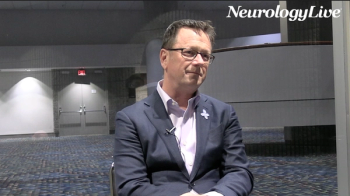
NeurologyLive® Year in Review 2022: Most-Watched Headache and Migraine Expert Interviews
These were the most-watched interviews with experts in headache and migraine that we conducted in 2022, brought to you as part of NeurologyLive®'s Year in Review.
In 2022, the NeurologyLive® team spoke with hundreds of people and posted hundreds of hours of interview clips. The staff spoke with neurologists, investigators, advanced practice providers, physical therapists, advocates, patients, pharmacists, and industry experts—anyone involved in the process of delivering clinical care.
These conversations were had with individuals from all over the world, both virtually and in person. The team attended more than 10 annual meetings of medical societies, each and every time sitting down with experts on-site to learn more about the conversations driving care and the challenges being overcome.
From those in the field of headache and migraine this year, we learned about the challenges in conducting clinical trials among specific populations, mental health's relationship with disease, the current state of emergency migraine care, and many other topics. Thematically, 2022 marked a year of improved understanding of migraine neuroscience and discussions of novel therapeutic approaches.
Here, we'll highlight the most-viewed expert interviews on NeurologyLive® this year. Click the buttons to watch more of our conversations with these experts.
1. Conducting Clinical Trials in Pediatric Migraine: Christina Szperka, MD, MSCE
The director of the Pediatric Headache Program at CHOP spoke on the challenges associated with clinical trials in pediatric migraine, further discussing the biggest advance made amid the COVID-19 pandemic. WATCH TIME: 6 minutes
“The CHAMP study showed that there were a lot of adverse effects in those meds, particularly topiramate. So, if we have another therapy that does ultimately have long-term safety and fewer adverse effects and that's easier in terms of adherence, maybe then the prescription patterns will eventually shift. But for right now, early on, when they meds have only been approved in adults for a couple of years, it's hard sometimes for parents to say, ‘I want to put my child in that study.’ That's something that we wrestle with, and it just depends.”
2. Connections Between Migraine and Mental Health: Lawrence Newman, MD
The chair of the American Migraine Foundation spoke about the insight gleaned from a recent survey the foundation conducted assessing links between mental health and migraine care. WATCH TIME: 4 minutes
“The take-home message really was that there was a significant impact between migraine and mental health on each other, and it's important, therefore, that people who live with this disabling condition—migraine—have an understanding that if they improve their mental health, they'll have better outcomes as related to their migraine and vice versa.”
3. The Variation in Migraine Management in Emergency Departments: Anne-Maree Kelly, MD
The director of the Joseph Epstein Center for Emergency Medicine Research provided context on the types of research needed to further evaluate and improve the diagnosis and management of headache in emergency departments. WATCH TIME: 3 minutes
"What about the downstream impacts like cost or service delivery? For those things, we would again need some prospective studies, but also with a follow-up period because what we couldn’t collect was the things we missed. How many misdiagnoses do we make? How can we avoid that? How could we improve the sensitivity of our process?"
4. Medical Crossfire on the Paradigm Shifts in Migraine Therapy: Jessica Ailani, MD
The director of the MedStar Georgetown University Hospital Headache Center tells her experience in a medical crossfire as the migraine cochair at the fourth annual International Congress on the Future of Neurology. WATCH TIME: 5 minutes
“I will tell you that in headache medicine, I really struggled with telemedicine. I personally think there are a couple of benefits to it, but there are a lot of challenges that people don't talk about. The challenge of licensing in multiple states, [for example]. I think that many providers think you're just covered if you're licensed in 1 state and that's actually not true.”
5. The Treatment of Status Migrainosus in Emergency Care Settings: Matthew Robbins, MD
The neurologist at Weill Cornell Medicine and NewYork-Presbyterian Hospital offered his insight into the state of treatment for status migrainosus and whether or not the new migraine medications can help improve care. WATCH TIME: 2 minutes
“There’s thought that, say there was a high-risk population who could lapse into status migrainosus, or they do, in the emergency room. If you gave them this IV medication, [eptinezumab], not only could it get them out of the emergency room and feeling better in the moment, it could prevent the onset of status migrainosus.”
6. Advantages in Adding Intranasal Zavagepant to the Migraine Treatment Landscape: Richard B. Lipton, MD
The director of the Montefiore Headache Center provided commentary on how analyses presented at AHS 2022 further support the benefits intranasal zavagepant brings to the migraine treatment landscape. WATCH TIME: 5 minutes
"Overall, migraine therapy is not a one-size-fits-all circumstance, and the encouraging thing in this study is that there’s strong efficacy and safety to support a new rapidly acting nasal formulation of a gepant might soon become available for patients who need it and for doctors to prescribe."
7. Anxiety and Depression in Children and Adolescents With Migraine: Serena L. Orr, MD, MSc
The pediatric neurologist and headache specialist at the University of Calgary discussed the work she presented at AHS 2022 on the incidence of anxiety and depressive disorders in the pediatric migraine population. WATCH TIME: 6 minutes
“What we found is that children and adolescents with migraine have a much higher burden of anxiety symptoms. When we looked at that at the meta-analysis level, the effect size was very large, and there was also a doubling of the odds of having an anxiety disorder in this population compared to healthy controls. [We saw] similar findings for depressive symptoms.”
8. Building the Next Generation of Migraine Specialists: Rashmi B. Halker-Singh, MD, FAAN, and Paul Mathew, MD, DNBPAS, FAAN, FAHS
The chair and vice-chair of the Headache and Facial Pain Section of the American Academy of Neurology provided insight on projects they feel are needed to advance the care of patients with migraine-related disorders. WATCH TIME: 4 minutes
"Despite how young we look, we both graduated from fellowship quite a while ago. I believe at the time there were 8 or 10 fellowship programs, and now there are over 40. That speaks volumes about how people are realizing the importance and value [in them], particularly in academic centers."
9. Assessing Psychedelics for Therapeutic Potential in Cluster Headache: Bryan Roth, MD, PhD
The Michael Hooker Distinguished Professor and director of the NIMH psychoactive drug screening program at University of North Carolina School of Medicine shared his insight into his keynote address at the American Headache Society Annual Scientific Meeting. WATCH TIME: 8 minutes
“One of the things that has intrigued me recently is whether the psychedelic experience is essential for the action of psychedelic drugs. There is currently a huge debate about this, about whether you could ‘microdose’ psychedelics and might that, ultimately, be as effective as taking a large dose at once; or, you could potentially create drugs that are not psychedelic that interact with the same serotonin receptors in the brain and outside the brain in such a way that they don’t create a psychedelic experience.”
10. Neuronal Complexity in a Model of Migraine: Amynah Pradhan, PhD
The associate professor of psychiatry at the University of Illinois at Chicago shared the findings of her and colleagues’ work that suggests that distinct cytoarchitectural changes occur in the brain that may underlie migraine chronification. WATCH TIME: 4 minutes
“It's really important to understand that neurons in our brain are not just static, 2-dimensional things. In fact, they're constantly moving and changing and responding to the environment around them. What that means is that they're sending out neurites, and they're retracting neurites. So, when we say that there's decreased neuronal complexity in these models, what that means is that they may be sort of less flexible and less responsive to their environment.”
Newsletter
Keep your finger on the pulse of neurology—subscribe to NeurologyLive for expert interviews, new data, and breakthrough treatment updates.


































